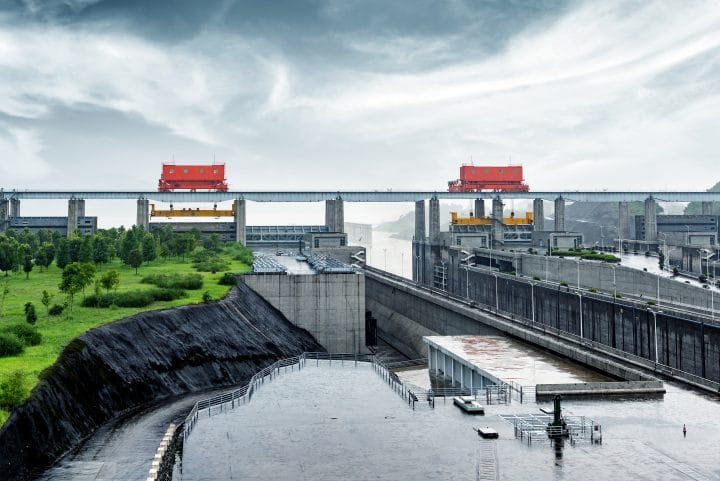Hydroelectric power is a clean energy solution. It is generated on a large scale at hydroelectric power plants all over the world. But does hydropower contribute to climate change? This article takes a closer look at some of its environmental drawbacks.
Hydropower and Methane Emissions
Whilst hydropower is a clean and renewable energy source, it can also be responsible for releasing methane into the atmosphere. Methane is one of the primary greenhouse gases along with carbon dioxide, nitrous oxide, ozone, and water vapor. Together, these gases are responsible for global warming and climate change.
The relationship between hydropower and methane is a complex one. This involves multiple factors which we should take into consideration. Some are responsible for releasing methane, whereas others are responsible for reducing methane emissions.
How Hydroelectric Dams Release Methane
The release of methane by hydroelectric dams is mostly a side effect of how they are built. In some cases, they can also release methane over longer periods. Let’s now take a look at how this happens.
1. By Submerging Vegetation
As engineers construct a dam wall, water builds up behind it. This creates an artificial reservoir that the dam will draw water from to power its turbines. The problem with this is what happens to the land that will become a reservoir.
As water builds up behind a dam wall, it begins to flood a large area. This intentional flooding consumes anything in its path, including vegetation. When vegetation is submerged in water, it begins to decompose due to a lack of oxygen. This process can release significant quantities of methane into the atmosphere over a short period of time.
In some areas where reservoirs can be formed without a major loss of vegetation (such as desert rivers), the impact is minimal. The Hoover Dam in the United States is a key example of this. The banks of its reservoir are rocky and dry with minimal vegetation to decompose. But, in areas with lots of vegetation, the impact can be high. An example of this is the Three Gorges Dam in China which flooded a large area rich in vegetation.

2. By Supporting Algae Growth
Hydroelectric dams and reservoirs can also support the growth of algae. This group of aquatic organisms is a major source of global methane emissions.
Population growth and climate change over the next century will increase the number of algae blooms in the world’s lakes and reservoirs. According to the Yale School of Forestry & Environmental Studies, this is likely to increase global methane emissions by between 30 and 90 percent.
How Hydroelectric Dams Reduce Methane Emissions
It’s not all doom and gloom though. In some cases, hydroelectric dams might actually be responsible for reducing methane emissions. When water is dammed, this can have significant impacts on areas downstream.
Hydropower facilities are often built across large, powerful rivers. Such rivers are often responsible for significant flooding along their course. A dam can help in two ways; hydropower generation and flood control. When flood control is a factor, a dam wall can control the flow of water to areas downstream. This can almost eliminate the risk of a river breaching its banks.
By reducing the risk of downstream flooding, hydroelectric dams have the potential to reduce overall methane emissions. This is possible due to the fact that downstream flooding no longer submerges vegetation. As a direct result of this, the vegetation does not decompose and release methane in the process.
Along rivers that might flood regularly at different locations, this impact is even greater. The reduction in methane emissions downstream can far outweigh the methane emissions of the hydroelectric reservoir itself.
Hydropower and Carbon Reduction
When looking at whether hydropower contributes to climate change or not, we should also consider its potential to reduce carbon emissions. As we explained earlier, carbon dioxide is a primary greenhouse gas that can contribute to global warming.
Each and every day, the world consumes vast quantities of fossil fuels such as coal, oil, and natural gas. Unlike hydropower, fossil fuels are burnt to provide a source of energy. In fact, all other sources of renewable energy (with the exception of biomass) have the same benefit over fossil fuels.
When we burn fossil fuels, we release significant levels of carbon dioxide into the atmosphere. When a hydropower plant uses water to generate electricity, it releases zero carbon emissions. As a direct result, this can help to curb the effects of global warming.
At the end of 2018, 50% of all renewable energy capacity came from hydropower alone. This was more than wind and solar put together! When we take this into account, you can see how hydropower is a major factor in carbon reduction. Whilst methane emissions can be considered a negative of hydropower, carbon reduction is clearly a positive aspect of it.
Conclusion
Where companies plan and manage hydroelectric facilities in a sustainable way, they do not contribute to climate change. This involves choosing a location with minimal vegetation, thus reducing the impact of methane emissions. In cases where engineers build hydroelectric dams in areas rich in vegetation, this can release significant levels of methane. As a direct result, this can contribute to climate change and global warming.
Regardless of the level of methane emissions a hydroelectric dam might generate, it still has the potential to actually curb global warming. This is due to the amount of carbon reduction it is responsible for. Hydropower dams eliminate carbon dioxide emissions in energy production, unlike traditional power plants.
We can conclude that whilst there is clear evidence to suggest hydropower does contribute to climate change, in some cases it might actually have the opposite effect.
You might also like to take a look at our article on the environmental impacts of hydroelectric dams. This covers additional topics, including the effect they can have on wildlife.